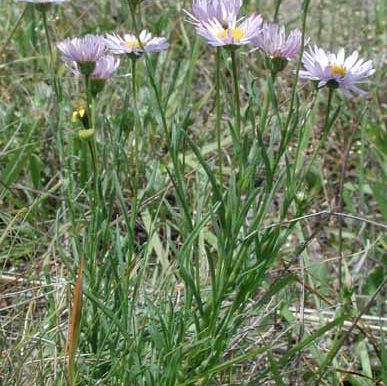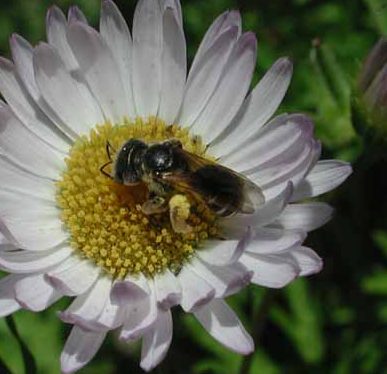Willamette daisy
Erigeron decumbens var. decumbens (Willamette daisy)
by Rhoda M. Love PhD, former President, Native Plant Society of Oregon

The Native Plant Society of Oregon can take direct credit for the fact that Willamette daisy, one of western Oregon’s beautiful but rare summer wildflowers, has recently (January, 2000) been listed as endangered by the US Fish and Wildlife Service. Along with two other Willamette Valley wetland plants, Bradshaw’s desert parsley, and Kincaid’s lupine, the tall, showy blue-flowered Willamette daisy now has federal protection. NPSO’s lawsuits in 1992 and 2003, as well as our numerous letters to Congresspersons, Senators, and the Wildlife Service over many years, helped persuade the our federal government to list these vanishing species, as well as to designate critical habitat for them.
Willamette daisy is endemic to the Willamette Valley of Oregon and was likely at one time widespread through this region. However, by the end of the 1970s, the plant was considered extinct, the last collection having been made in 1934. Fortunately, in 1980, two small populations were rediscovered, but then, tragically, in 1986, the largest population known over 6,000 plants–was destroyed by plowing. Today the eighteen remaining populations are scattered in seven Oregon counties, representing perhaps 7,500 total plants. One site near Eugene has a population that varies between 1,000 and 3,000 plants.
Erigeron decumbens is a showy, tall, blue- or pink-flowered perennial that often grows in clumps and can reach nearly five feet in height — early Willamette Valley pioneers described wildflowers as high as the belly of a horse. Each tap-rooted individual, with its numerous stems, may bear 20 to 30 heads.

On robust plants, these heads may be nearly 4 centimeters across, with yellow disk flowers and blue (sometimes pale pink) rays. Most of its long narrow leaves have three veins. Willamette daisy blooms in our Willamette Valley wetlands in June and early July. The species, although once common throughout the prairies of northwestern Oregon, is now restricted to small scattered sites from southern Washington County to the Eugene area of Lane County. Its habitat has vanished since pioneer times due to draining and filling of wetlands, agriculture and grazing, and urbanization, as well as unmonitored hot prairie fires, competition with invasive species, and secondary succession of shrubs and trees. Today, fewer than one percent of the original wetlands of this area remain, compared with the pre-settlement condition.
Willamette daisy requires heavy soils in seasonally wet, open grasslands. The plant is shade-intolerant, an early-successional species which depends on flooding and fire to maintain its open prairie habitat. Its pollinators are various insects including sweat bees, syrphid flies, and the field crescent butterfly. A study published in 1997 revealed that Willamette daisy has a very low percentage of viable seeds (only 2-19% were shown to contain living embryos). However, most seed with embryos germinated in laboratory tests. The researchers reported some success in propagating the plant via cuttings. Because of its status as a rare plant, Willamette daisy is not available to home gardeners. In 2006 USFWS designated critical habitat in Benton, Lane, Linn, Marion and Polk Counties five of seven counties where the plant is known to occur. The other two are Washington and Yamhill.

Erigeron decumbens was discovered and collected by the indefatigable and eccentric English-born botanist Thomas Nuttall (1786-1859), on his famous 1834-35 overland trip with John Kirk Townsend to the Columbia River. Nuttall was not always a careful note-taker, thus the exact locations of some of his collections are problematical. In fact he claims to have encountered the daisy in the Rocky Mountains toward Oregon, however, we can be reasonably certain that he found the plant in the Willamette Valley since it has never been known to grow elsewhere. Nuttall published the name, Erigeron decumbens, in 1840; most of his specimens are preserved at Philadelphia, Harvard, and the British Museum. No type specimen has been designated for E. decumbens. Nuttall may have chosen the name decumbens because this tall plant often falls over or becomes decumbent due to prairie winds and rains. Botanists also use this term for plants that have a curved base below upright branches. Nuttall’s name remained unchanged for 107 years until 1947, when Arthur Cronquist, the American expert on the sunflower family, wrote a revision of the genus Erigeron. While working with CL Hitchcock on the flora of the Pacific Northwest, Cronquist recognized a California variety of E. decumbens that he named var. robustior. This automatically changed the name of our Willamette daisy to Erigeron decumbens var. decumbens. However, that is not the end of the story, because Guy Nesom, who has written the treatment for Flora of North America, now recognizes E. robustior as a species in its own right. Thus, according to the rules of botany, the name of our daisy once again becomes Erigeron decumbens, restoring Nutall’s original 1840 name.
Bibliography:
- Center for Plant Conservation. Erigeron decumbens var. decumbens.
- Chambers, K. 2007. Personal correspondence.
- Clark, DL, Ingersoll, CA, Finley, KK, 1997. Regeneration of Erigeron decumbens var. decumbens (Asteraceae), the Willamette Daisy. IN: Kaye TN et al, Conservation and management of native pants and fungi. Native Plant Society of Oregon, Corvallis.
- Cronquist, A. 1947. Revision of the North American species of Erigeron. Brittonia 6:121-302.
- Dept of Interior, Fish and Wildlife Service. October 2006. Designation of Critical Habitat for three Willamette Valley species.
- Federal Register. June 15, 2006, Vol. 71, No. 115. Proposed designation of critical habitat for Erigeron decumbens.
- Hitchcock CL, A. Cronquist, M. Ownbey, JW Thompson. 1955. Vascular plants of the Pacific Northwest, Part 5.
- McKelvey, SD. 1956. Botanical exploration of the trans-Mississippi west 1790-1850. Harvard University.
- Meinke, R. 1982. Threatened and endangered vascular plants of Oregon: an illustrated guide. US Fish and Wildlife Service, Portland.
- Nesom, G. 2(2006) Flora of North America treatment of genus Erigeron. Erigeron decumbens Vol. 20, p. 279
- Nuttall, T. 1840. Trans. Am. Phil. Soc. 7:309.
- Oregon Flora Project. Map: Distribution of Erigeron decumbens (PDF, 806kb, includes photos). OFP, Oregon State University and OSC Herbarium.
- Oregon Natural Heritage Information Center, 2004. Rare, threatened and endangered plants of Oregon, Oregon State University, Portland. ONHIC web site
- Thorpe HS, and TN Kaye 2006. Erigeron decumbens ssp. decumbens (Willamette Daisy) Population monitoring and evaluation of mowing and burning at Oxbow West, West Eugene wetlands, BLM Eugene District and Institute of Applied Ecology. ka***@**ak.org
